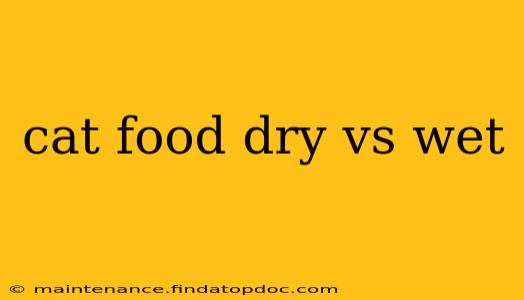Choosing the right cat food can feel overwhelming. With so many brands and types available, understanding the differences between dry and wet food is crucial for ensuring your cat receives optimal nutrition. This comprehensive guide will delve into the pros and cons of each, helping you make an informed decision based on your cat's individual needs and preferences.
What are the main differences between dry and wet cat food?
The most significant difference lies in moisture content. Dry cat food, also known as kibble, has a moisture content of around 10%, while wet food boasts a much higher percentage, typically between 70-80%. This difference dramatically impacts several aspects of your cat's health and well-being.
Is wet food better for cats than dry food?
There's no single "better" option; the ideal choice depends on your cat's specific needs and your lifestyle. Wet food generally offers several advantages:
- Higher moisture content: This is arguably the biggest benefit. Cats are naturally inclined to drink less water than they should, making wet food crucial for maintaining proper hydration, particularly important for preventing urinary tract issues.
- Palatability: Many cats find wet food more appealing than dry kibble, especially those with picky eating habits. The richer aroma and texture often entice even the most discerning feline.
- Nutrient density: Some wet foods offer higher levels of certain nutrients compared to dry food, though this varies significantly between brands and formulations.
However, wet food also has drawbacks:
- Higher cost: Wet food is generally more expensive than dry food, potentially making it a less budget-friendly option for owners with multiple cats.
- Shorter shelf life: Once opened, wet food spoils more quickly than dry food, necessitating refrigeration and potentially leading to waste.
- Messiness: Wet food can be messier than dry kibble, requiring more frequent cleaning of food bowls.
Is dry food better for cats than wet food?
Dry food offers its own set of advantages:
- Cost-effectiveness: Dry kibble is usually cheaper per calorie than wet food, making it a more economical choice for many cat owners.
- Convenience: Dry food has a longer shelf life and doesn't require refrigeration, making it easier to store and manage.
- Dental health: The chewing action involved in eating dry kibble can help to clean your cat's teeth, reducing the risk of plaque buildup.
However, dry food also has limitations:
- Lower moisture content: The lower moisture content can contribute to dehydration, increasing the risk of urinary tract infections and other health problems.
- Less palatable: Some cats find dry food less appealing than wet food, leading to picky eating and potential nutritional deficiencies.
- Lower nutrient density (potentially): While some dry foods are highly nutritious, others might lack certain nutrients found in higher concentrations in wet food.
What type of cat food is best for urinary tract health?
Maintaining proper hydration is paramount for urinary tract health. While both wet and dry foods can be part of a healthy diet, wet food's higher moisture content generally makes it a better choice for cats prone to urinary tract issues. Always consult your veterinarian for specific recommendations based on your cat's individual needs. They can advise you on the best food choices, taking into account breed, age, activity level, and any pre-existing health conditions.
Can I feed my cat both wet and dry food?
Yes, absolutely! Many cat owners successfully incorporate both wet and dry food into their cat's diet. This can offer a balance of convenience, cost-effectiveness, and nutritional benefits. You can offer a combination of wet food for moisture and dry food for dental health and prolonged satisfaction. However, always monitor your cat's water intake and overall health to ensure the combined diet is meeting their nutritional requirements.
How much wet and dry cat food should I feed my cat?
The appropriate amount of food depends on your cat's age, weight, activity level, and the specific food's caloric density. Always follow the feeding guidelines on the food packaging, using your cat's weight as a guide. If you're unsure, consult your veterinarian to determine the optimal feeding schedule and portion sizes for your feline companion. Regular weight checks and monitoring of your cat's body condition are crucial for ensuring their well-being.
Remember, this information is for general guidance only. Always consult your veterinarian for personalized advice on the best diet for your cat's unique needs. They can help you choose a food that supports their health and longevity.
